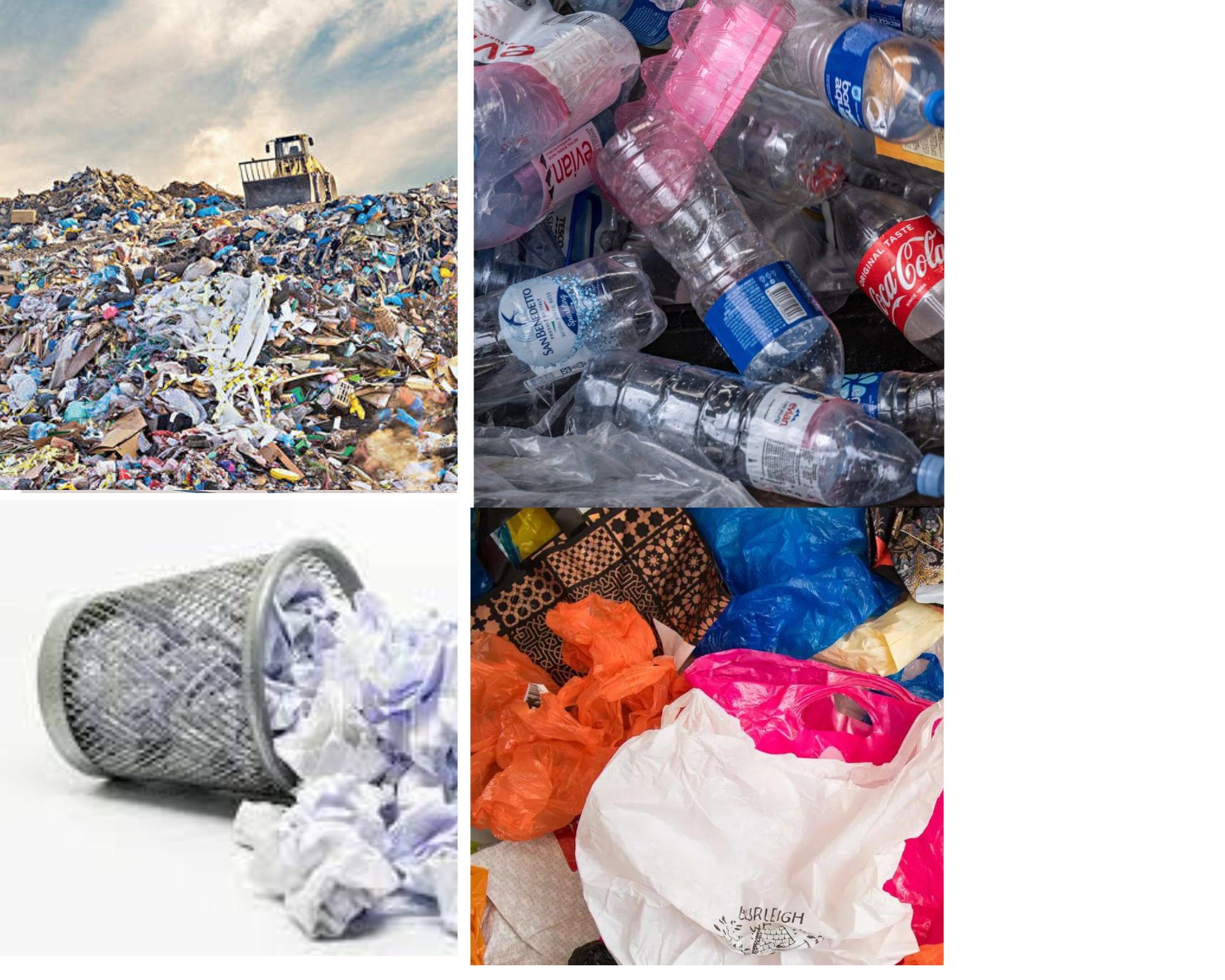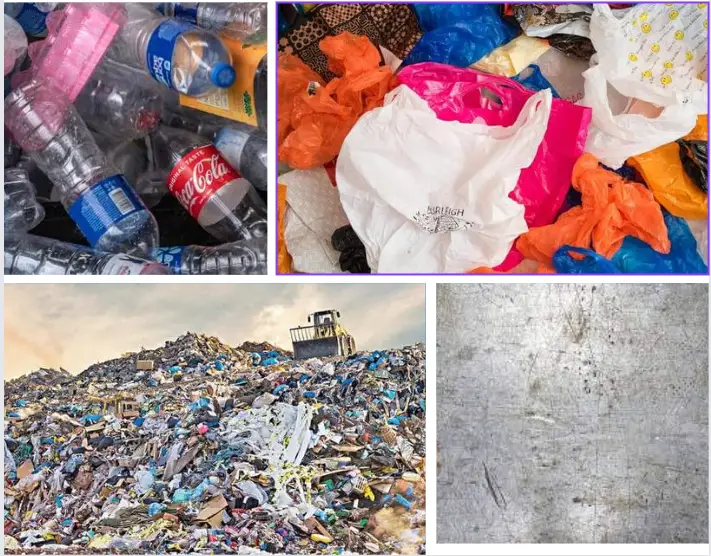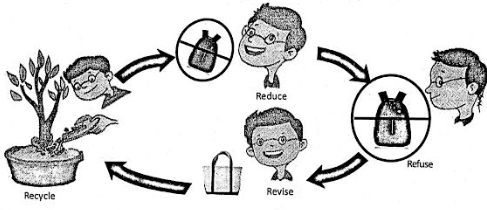Chapter 12 Waste Products Waste Products
Origin and Nature-The waste products of our home and their reuse :
In urban communities everywhere they are producing huge quantities of household and commercial waste. Most of you have seen heaps of rubbish or garbage dumped at the roadside or in the dustbin.
You may have noticed a dustbin in your house or on the roadside usually unused things such as plastic, packets, old bottles, parts of vegetables, damaged or unused papers, broken glass pieces, boxes, etc. are thrown in the dustbin.
Read and Learn More WBBSE Notes For Class 6 General Science and Environment

| Class 6 History | Class 6 Social Science |
| Class 6 Geography | Class 6 Science |
| Class 6 Maths | Class 6 Science MCQs |
| Class 6 General Science | Class 6 Maths Solutions |
| Class 6 Geography | Class 6 Hindi |
Sometimes you may have also seen your parents, to sale some old papers, plastic bottles, some pieces of metal, broken glasses, etc to some salesman or rag-pickers. These throwaway items are called waste products.
“WBBSE Class 6 General Science Chapter 12 waste products notes”
Waste is unwanted or unusable materials which are rejected after primary use or have no further use.
Make a list of things of your house that already have been discarded.
| Articles discarded | Sources | |
| From house | From kitchen | |
| 1. | ||
| 2. | ||
| 3. | ||
| 4. | ||
Now the question is why we discard things. Usually, we discard things because these things occupy a lot of space and these have no further use in that format.
“Methods of waste disposal Class 6 WBBSE Science”
Moreover, organic products such as rotten vegetables and vegetable peels spoil the hygienic atmosphere of our house.
Make a list of waste products around you and complete the table.
| List of Waste Products | Do they occupy space? | How much space do they occupy? | Do they have definite weight? |
| 1. Paper boxes | |||
| 2. Plastic boxes | |||
| 3. Pieces of thermocol | |||
| 4. Old blades | |||
| 5. Rotten fruits, vegetables | |||
| 6. Old batteries | |||
| 7. Electrical broken parts | |||
| 8. Unused mobile parts | |||
| 9. | |||
| 10. |
The traditional method of disposal of waste is by dumping the rubbish in landfill sites. such as disused quarries and grovel pits.
If you notice in a dustbin or garbage, a heap of vegetable peels, banana and other fruit peels, paper packets, jute products, straw products or other plant products decompose easily and mix with soil within a few days whereas plastic or polythene packets, bags and bottle pieces of glass, tin, cans, radio, television, electrical and computer parts remain unchanged, neither decompose nor mix with soil.
“Class 6 WBBSE General Science Chapter 12 types of waste products explained”
The former products are biodegradable and later products are known as non-biodegradable products. The waste products that easily decompose and get mixed with the soil are called Biodegradable products and the waste products that do not decompose even after remaining in the soil for a long time are called Non-Biodegradable.
Make a list of Biodegradable and Non-Biodegradable products around you.
| Throwaway products | Biodegradable | Non-Biodegradable | |
| 1. | |||
| 2. | |||
| 3. | |||
| 4. |
Try to keep two separate colored waste buckets or baskets in your house and in your classroom or in school and label them as Biodegradable and Non-Biodegradable. Keep degradable and non-degradable waste products separately in two bucket baskets.
“Step-by-step notes on waste products Class 6 WBBSE”
Besides this, you keep another bucket of the basket to keep recyclable waste products such as paper, plastic packets, plastic, bottles, and metallic substances.

Identify the biodegradable and non-biodegradable products from the above-mentioned pictures and complete the table below.
| Products | Biodegradable | Non-biodegradable |
| 1. | ||
| 2. | ||
| 3. | ||
| 4. |
Let’s see some waste products and from where they come (sources)
| Waste products | From where they come (Sources) |
| 1. Broken glass parts, lamp. | Houses and public dustbin. |
| 2. Plastic bottles, polythene bags, etc. | Houses. |
| 3. Packets, wood pieces, dust. | Shops and from different commercial activities |
| 4. Rotten vegetables | Market places |
| 5. DDT, BHC, and other pesticides. | Agricultural land |
| 6. Broken pipes, plastic, asbestos, etc. | From construction place |
| 7. Syringes, cotton, used glasses, plusters, % medicine foiles, etc. | Hospitals and other health centers |
| 8. Chemical wastes, oil, etc. | From factory |
From the above waste materials complete the table below.
| Products/materials | Types of waste | Remarks | ||
| Bio-degradable | Non-bio degradable | Useful | non-useful | |
|
|
||||
All the waste that we generate can be categorized into three types
- Bio-degradable.
- Non-Biodegradable and
- Recyclable.
The Biodegradable materials can be put into deep pits in the ground and be left for natural decomposition (breakdown). Non-biodegradable waste to be disposed off.
The three R’s-reduce, reuse, and recycle-all help to cut down on the amount of waste we throw away. They conserve natural resources, landfill space, and energy.
“WBBSE Class 6 General Science Chapter 12 important questions and answers”
We can use newspaper for packaging, broken plastic buckets as dustbins, carrier bags can be reused in shopping, and when possible carry goods in a bag. By this way you can reduce the use of plastic bags. Don’t ask for plastic bags, use your old bag.
Chapter 12 Waste Products Reusing Waste Products
Reusing Waste Products:
Many items found around the home can be used for different purposes. So before you throw these items away think about how these things can be reused.
Reuse is the action or practice of using something again whether for its original purpose (known as conventional reuse) or to fulfill a different function (known as creative reuse).

Benefits Of Reuse
- Reuse and reduce hazardous waste.
- It reduces air, water, and land pollution.
- Limits the need for new natural resources, such as timber, petroleum, fibers, plastic products, etc.
- Gives economic benefits.
Since the introduction of the EPA’s Reduce, Reuse, Recycle campaign, many have adopted recyclable waste management systems.
Some home items we can save from trash and instill new life and purpose.
Items We Can Reuse
- Glass jars, containers or cans.
- Gallon jugs, plastic soda bottles, and other plastic containers.
- Newspapers, magazines, hard boards, paper bags, etc.
- Clothes, towels, bedding, etc.
- Seeds.
- Plastic bags.
- Bathroom items like toothbrushes or other brushes, toothpaste tubes, shop care, etc.
- Broken dishes
- Old furniture.
- Metalic substances.
You can reuse many organic waste items like egg cells, rotten vegetables, teabags, peels of fruits, leaves, scales of fish, etc. converting them into composite fertilizer. These can be used to grow plants in your garden.
“Solved examples of waste products and their disposal WBBSE Class 6 Science”
Papers, plastics, glasses, etc. can be recycled and would be the raw material for new products. So don’t through all these things in the dustbin as waste.
Separate these things which can be recycled and hand over these things to the particular rag-pickers or ‘kabadiwallahs’. With these 3 ‘R’s we can refuse some items such as plastic bags for each product, and plastic bottles as containers.
In spite of these, we can use our own utensils to carry cloth or other natural fiber carry bags when we go to shopping and reuse polythene bags. Therefore, we can adapt the 4Rs (Reduce, Refuse, Reuse, and Recycle) to reduce the waste items.
Complete the table with 3 types of waste items
| Waste items | Categories | Recyclable | |
| Bio-degradable | Non-biodegradable | ||
| 1. Plastic bags | Yes | Yes | |
| 2. Paper | Yes | Yes | |
| 3. Rubber | Yes | Yes | |
| 4. Food wastes | Yes | ||
| 5. Glass | |||
| 6. Metals | |||
| 7. Leather | |||
| 8. Textile | |||
| 9. | |||
| 10. | |||
| 11. | |||
| 12. | |||
Rejected computers, mobile, its parts, and other electronic goods are known as electronic waste or e-waste. Recycling is the only solution for the treatment of e-wastes.
“Best guide for Class 6 General Science WBBSE waste management”]

WBBSE Notes For Class 6 General Science and Environment
-
- Chapter 1 Interdependence of Organisms and the Environment
- Chapter 2 Phenomena Around Us
- Chapter 3 Element, Compound and Mixture
- Chapter 4 Rocks and Minerals
- Chapter 5 Measurement
- Chapter 6 Primary Concept of Force and Energy
- Chapter 7 Statics and Dynamics of Fluid
- Chapter 8 The Human BodyChapter 9 Common Machines
- Chapter 10 Biodiversity and its Classification
- Chapter 11 Habits and Habitats of Some Important Animals
- Chapter 12 Waste Products
